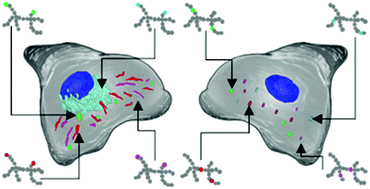Polymer design and component selection contribute to uptake, distribution & trafficking behaviours of polyethylene glycol hyperbranched polymers in live MDA-MB-468 breast cancer cells†
Abstract
As polymeric nanomedicines grow increasingly complex in design, an effective therapeutic release is often inherently tied to localisation to specific intracellular compartments or microenvironments. The inclusion of environmentally-sensitive moieties links the functionality of such materials to the trafficking behaviours exhibited once materials have obtained access to the cellular milieu. In order to perform their designed function, such materials often need to encounter specific biological cues or stimuli. As such, there is an increased need to improve our understanding of how the physicochemical properties of nanomaterials influence post-internalisation behaviours. Amongst the unknown factors that may contribute to the trafficking behaviours and distribution of polymers within the cellular environment, is the influence of the components selected in the development of such materials. To examine whether composition and arrangement of components within small polymeric nanomaterials contribute to their ability to navigate the intracellular space, here we utilise fluorophores to model component selection, varying the fluorescent handle selected and its method of incorporation. We explore the intracellular behaviours of well-characterised hyperbranched polymers in live MDA-MB-468 breast cancer cells in vitro. Changes in distribution as a function of both fluorophore selection and placement are reported, and our data suggest that the individual components used to produce potential nanomedicines are critical to their overall functioning and efficacy. Further to this, through the use of a novel non-conjugated targeting ligand, we demonstrate that there is inherent competition between component-directing factors and cellular influences on the ultimate fate of the polymers. The behaviours reported here suggest that not only does component selection contribute to intracellular processing, but these factors could potentially be harnessed when designing polymers to ensure improved functionality of future materials for therapeutic delivery.



 Please wait while we load your content...
Please wait while we load your content...